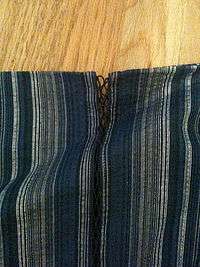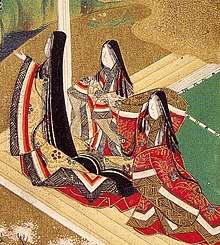Jinbei
A jinbei (甚平), alternately jinbē (甚兵衛) or hippari (ひっぱり), is a kind of traditional Japanese clothing worn by men, women, boys, girls, and even babies during the summer. Women's jinbei have started to become popular in recent years.


Use
Jinbei is usually worn as a form of nightwear or house wear. Normally, men wear jinbei only in their own homes or when close to home (usually to collect the mail, go on a local errand, or while shopping or dining at a local restaurant). Sometimes jinbei is used as a substitute for yukata during a summer festival, typically by men and boys but also frequently by young women. Ladies' jinbei tend to be more brightly colored and often feature prints of popular culture characters and motifs.
The whale shark is also known as jinbei-zame (ジンベイザメ(甚平鮫), "jinbei shark") or jinbē-zame (ジンベエザメ 《甚兵衛鮫》, "jinbee shark") in Japanese due to its skin patterns resembling those of jinbei.
Set
Jinbei sets consist of a top and matching shorts, although some have long pants and some come with both short and long pants. Traditional jinbei are made from hemp or cotton and are dyed a uniform color, often indigo, blue, or green (though modern jinbei frequently have prints ranging from simple textures or lines to complicated and colorful floral patterns). The top resembles a short-sleeved or sleeveless jacket that falls to the hips. It ties closed both inside and outside the jacket, with the inside tied first, the jacket folded over to the person's right, and then tying the outside.
The seam for jinbei is very loosely woven to allow for ventilation during hot weather while retaining coverage.
References
External links

